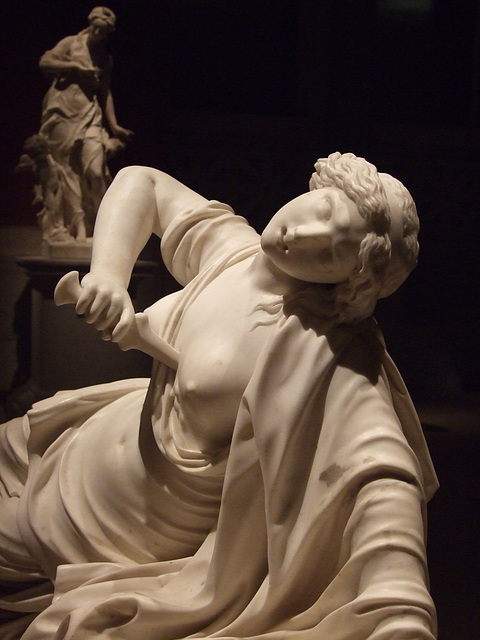See also...
Keywords
Authorizations, license
-
Visible by: Everyone -
All rights reserved
-
128 visits
Detail of Lucretia by Bertrand in the Metropolitan Museum of Art, November 2009


Title: Lucretia
Artist: Philippe Bertrand (French, 1663–1724)
Date: 1704 or earlier
Culture: French, probably Paris
Medium: Marble
Dimensions: Overall (confirmed): 27 1/2 × 43 1/4 × 20 3/4 in., 686 lb. (69.9 × 109.9 × 52.7 cm, 311.2 kg)
Classification: Sculpture
Credit Line: Purchase, Harris Brisbane Dick Fund, Joseph M. Cohen Gift, and Fletcher Fund, by exchange, 2003
Accession Number: 2003.296
Lucretia's suicide out of shame for her rape by Sextus Tarquinius—a self-sacrifice that led to the rebellion in Rome against the Tarquins— was frequendy depicted in prints and paintings, though less often in sculpture, from the sixteenth through the eighteenth century. In France during this period femmes fortes, powerful women from ancient history or myth, such as Lucretia, Cleopatra, and Dido, as well as from the Bible, such as Esther, Jael, and Judith, were popular paragons of virtue. This sculpture shares many characteristics of the morceaux de réception, works required of candidates for admission to the Académie Royale de la Peinture et de la Sculpture in Paris. About 1700 these showcases of the sculptor's talents tended to be highly dramatic, under-lifesize marble sculptures of classical subjects. Lucretia appears to be the figure that Bertrand, one of the talented generation of sculptors who participated in royal projects at Versailles, displayed at the Salon of 1704. Exceptionally, Bertrand submitted a bronze sculpture as his academy reception piece in 1701; possibly, he carved Lucretia in the manner of the morceaux de réception to demonstrate his talents in marble.
Text from: www.metmuseum.org/art/collection/search/212215
Artist: Philippe Bertrand (French, 1663–1724)
Date: 1704 or earlier
Culture: French, probably Paris
Medium: Marble
Dimensions: Overall (confirmed): 27 1/2 × 43 1/4 × 20 3/4 in., 686 lb. (69.9 × 109.9 × 52.7 cm, 311.2 kg)
Classification: Sculpture
Credit Line: Purchase, Harris Brisbane Dick Fund, Joseph M. Cohen Gift, and Fletcher Fund, by exchange, 2003
Accession Number: 2003.296
Lucretia's suicide out of shame for her rape by Sextus Tarquinius—a self-sacrifice that led to the rebellion in Rome against the Tarquins— was frequendy depicted in prints and paintings, though less often in sculpture, from the sixteenth through the eighteenth century. In France during this period femmes fortes, powerful women from ancient history or myth, such as Lucretia, Cleopatra, and Dido, as well as from the Bible, such as Esther, Jael, and Judith, were popular paragons of virtue. This sculpture shares many characteristics of the morceaux de réception, works required of candidates for admission to the Académie Royale de la Peinture et de la Sculpture in Paris. About 1700 these showcases of the sculptor's talents tended to be highly dramatic, under-lifesize marble sculptures of classical subjects. Lucretia appears to be the figure that Bertrand, one of the talented generation of sculptors who participated in royal projects at Versailles, displayed at the Salon of 1704. Exceptionally, Bertrand submitted a bronze sculpture as his academy reception piece in 1701; possibly, he carved Lucretia in the manner of the morceaux de réception to demonstrate his talents in marble.
Text from: www.metmuseum.org/art/collection/search/212215
- Keyboard shortcuts:
Jump to top
RSS feed- Latest comments - Subscribe to the comment feeds of this photo
- ipernity © 2007-2025
- Help & Contact
|
Club news
|
About ipernity
|
History |
ipernity Club & Prices |
Guide of good conduct
Donate | Group guidelines | Privacy policy | Terms of use | Statutes | In memoria -
Facebook
Twitter











Sign-in to write a comment.